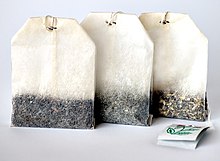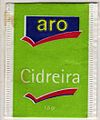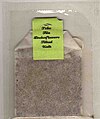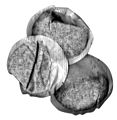Teabag
Tea bags or ( tea ) infusion bags , also known as tea bags in Austrian usage , are small containers made of special filter paper that contain tea . The everyday objects, which have existed since the first half of the 20th century and are now sold in the millions every year, are used for the uncomplicated preparation of tea drinks.
How to use
To prepare tea beverages, tea bags are poured with hot water in a cup , glass or teapot , and the tea is left to steep for different lengths of time, usually a few minutes , depending on the type of tea and personal preference . The method of immersing the teabag in already poured hot water is not very popular with passionate tea drinkers, since the aroma of the tea does not come into its own without direct infusion. For better handling, most tea bags have an attached or knotted string and a label (less common in Great Britain, Ireland and the USA). In the British Isles, where tea bags without a string or label are very often used, special gripping tongs are available to remove the tea bags from the cup or pot, with which the soaked tea bags can also be squeezed out.
The filling quantity of commercially available tea bags differs according to the type of tea and packer or brand; there is no relevant standard. The proportion of tea leaves and tea curd ( fannings ) in a bag is also different. The tea drinker has to find out for himself the ratio of tea and water that suits him. It can be assumed that the composition and amount of tea contained will remain the same over a longer period of time.
history
The tea bag principle was used at the latest in the Middle Ages for the introduction of medicinal drugs by means of a "herbal sachet " ( sacculus medicinalis or pulvinar medicinale ) made of linen in medicinal wines .
The forerunner of today's tea bag was unintentionally invented in 1904 or 1908 by the American tea merchant Thomas Sullivan. In order to avoid the weight problem when sending tea samples - at the time they were sent in large and expensive tin cans - Sullivan filled his goods in small, space-saving silk bags and sent them to customers. They used the small bags by submerging them completely in the water, believing that this was what Sullivan intended. This saved the procedure of straining and transferring the tea into a second pot.
Sullivan's business idea was initially very popular with customers because of its convenience, but the tea bag fell into disrepute in the 1910s, because imitators mixed additives such as low-quality herbs or fine-crumbly waste into the tea bags to reduce costs. So the opinion arose and continued to exist that tea bags generally contained tea of inferior quality.
To counter this misconception, the Briton John Horniman sealed the tea bags and guaranteed the quality with his name. Horniman glued the tea bags, which were now made of paper, with glue, which, however, affected the taste of the tea when it came into contact with hot water. Because paper bags stuck together with glue make the tea sticky, cotton with glue makes it musty. The spherical shape of the tea bags gave them the popular name "Pompadour" based on the spherical handbags that were very popular with women at the time.
During the First World War , the Dresden company Teekanne GmbH delivered tea in portions in small garbage sacks for the troops' catering. The soldiers gave the tea bag the name “tea bomb” because the tea in the bags colored the water brown, but the taste of the tea did not develop.
The type of teabag that is widely used today was invented by Adolf Rambold , an employee of the Teekanne company. In 1929 the company launched its first infusion bags made of specially manufactured, tasteless parchment paper and also marketed the tea bag packing machine developed by Rambold. In 1949 the “Constanta tea packing machine”, also created by Rambold, came onto the market. At the end of the same year, sales of the double-chamber bag with staple closure, patented by Teekanne and used to this day, began .
Rambold folded a rectangular strip of paper about six inches long into a tube, which was kinked roughly in the middle and filled with tea from both sides. The longer end was folded over the other and closed with a staple, creating two chambers. In this way, the tea is bathed in water over a larger area. The material turned out to be a problem. The bag should be tear-proof and heat-resistant and at the same time tasteless. The cotton bags used so far had a taste of their own. Rambold's new design consisted of around 30% cellulose and around 70% manila fibers , which went through a multi-stage process similar to papyrus production before they were further processed into tea bags. The fibers were soaked in water, placed on top of each other at right angles and pressed dry. Rambold's machine enabled the serial production of tea bags from manila fibers and cellulose and the filling of fine tea leaves.
Today's packaging machines fill up to 400 tea bags per minute. The Teekanne company produces 10 million tea bags every day. The East Frisian Tea Company with the Messmer brand sells around 11 billion tea bags annually.
range
Today, basically all kinds of tea are offered in bags. The leaves of black tea are divided into four leaf grades according to their size. Tea bags only contain tea of the two finer grades, Fanning (approx. 1 mm leaf remains) and Dust (sifted tea powder). In addition to tea bags with black tea in the traditional sense, there are now also those with green tea , white tea and semi-fermented oolong tea. Black tea with spices is often marketed under the name Chai (as a short form of Masala chai ), an international term for tea that is widespread in the Slavic and Arabic-speaking regions as well as in Asia .
There is also a large number of herbal and fruit teas, which have increasingly been offered in bags in recent decades. Many of them can also have health-promoting effects and are therefore not only sold in grocery stores, but also in pharmacies and drugstores .
With regard to the wellness concept, herbal and fruit teas in particular are often given names by the manufacturers that are intended to remind of health, relaxation and well-being and often no longer describe the actual contents of the tea bags, such as Mountain Harmony or stomach friend and good mood of the teapot brand. There are also names that link to the area of esotericism, such as Fairy Dream from the Milford brand , or Inner Harmony from the Yogi-Tea brand . A large part of such tea compositions is only available as tea in a bag.
Tea is sold in a bag with an outer packaging , which usually consists of thin cardboard and plastic film . The tea bags in this outer packaging can be loosely contained, provided with a paper envelope or, for aroma protection or prestige reasons, additionally individually sealed in plastic or metallized plastic .
Forms and subspecies
For reasons of food purity , tea bags are made without glue using a special folding process. The tea bag paper used today consists mainly of Abacá fibers, while alternatives are made of bioplastic fibers ( polylactide , PLA). The tea bag string is often covered with a film of wax so that the capillary action of the string does not cause the label to become soaked with tea.
In Central Europe, tea bags in the shape of a bag with a string are particularly common. In other countries there are also tea bags in other shapes, for example in the British Isles for some time flat, round tea bags that are placed on the bottom of a cup.
There are also empty tea filters made of tea bag paper or fabric, which are usually much larger than the filled tea bags. If necessary together with special holders, they are used to prepare tea from loose, not pre-portioned tea leaves.
The (mostly homemade) herb and spice bag , which you put in the broth when cooking soup, works in a similar way to tea bags , so that you can remove it after cooking without all herbs and spices floating in the soup.
An invention related to the tea bag is the coffee bag , a subtype of the coffee filter , for example as a coffee pad for the portion coffee machines of the Senseo and ESE-Standard systems provided for this purpose .
Pyramid-shaped tea bags made of polylactide
Environmental aspects
Since tea bags i. d. Usually consist of different materials (bag contents, bag, paper label, thread, staples), the question of correct disposal often arises. Municipalities and waste disposal companies point out that the bags can be thrown into the residual waste as well as into the organic waste .
When preparing bag tea, depending on the type of bag (e.g. pyramid bags made of nylon ), considerable amounts of microplastic can migrate into the drink.
Others
In catering, the tea bags can be placed on special tea bag plates after they have been pulled .
Due to the increasing variety and sometimes exotic ingredients, tea bag envelopes and tags are increasingly being collected , for which there are also corresponding catalogs . In addition, certain copies are regionally or seasonally limited.
See also
Web links
Individual evidence
- ↑ See for example Rainer Sutterer: Anton Trutmanns 'Pharmacopoeia'. Part I: Text. Medical dissertation Bonn 1976, p. 167 ("tuo es in eyn secklin and tuo es den in eyn hafen and poured a moss winß driber and let it boil", quoted from Hs. XI. 61 of the Burgerbibliothek Bern, sheet 73 r ).
- ↑ Ludwig August Kraus: Critical-Etymologisches medicinisches Lexikon. Verlag der Deuerlich- und Dieterichschen Buchhandlung, 1844, p. 909.
- ^ Friedrich Dobler: Conrad Gessner as a pharmacist. Mathematical and natural science dissertation, Zurich 1955, p. 52 ("pointed pouch" = "Manica hippocratica", filled with a drug mixture, for the production of small amounts of medicinal wine).
- ^ Ingrid Rohland: The 'book of old damage', Part II: Commentary and dictionary. (Medical dissertation Würzburg) Königshausen and Neumann, Würzburg 1982 (= Würzburg medical-historical research. Volume 23), p. 96.
- ↑ How to sell eleven billion tea bags a year , in Die Welt , online edition October 9, 2014, accessed August 30, 2015.
- ↑ See tealoungesystem.com , accessed on September 4, 2015.
- ↑ teekanne-shop.de , accessed on September 4, 2015.
- ↑ milford.de , accessed on September 4, 2015.
- ↑ Tea, filter, bag. District of Giessen , 2019, accessed December 8, 2019 .
- ↑ How do you dispose of tea bags? www.muelltonne.at, 2019, accessed on December 8, 2019 .
- ↑ Dispose of the tea bag. entsorgen.org, 2016, accessed December 8, 2019 .
- ↑ Laura M. Hernandez, Elvis Genbo Xu, Hans CE Larsson, Rui Tahara, Vimal B. Maisuria, Nathalie Tufenkji: Plastic Teabags Release Billions of Microparticles and Nanoparticles into Tea. In: Environmental Science & Technology. 2019, doi : 10.1021 / acs.est.9b02540 .
- ↑ Esther Widmann: Tea bags give off large amounts of microplastic. In: nzz.ch . September 25, 2019, accessed September 28, 2019 .
- ↑ A free online collector's catalog can be found at colnect.com/de/teabags , for example . Retrieved June 30, 2019 .











